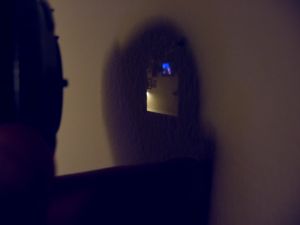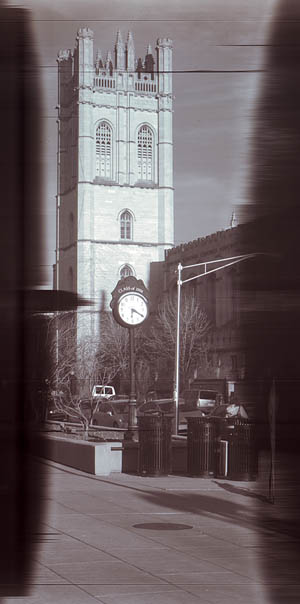
an image from a 50mm lens: the scene from the other room.
An even simpler optical system is the pinhole: Light rays are constrained in that there is one angle, and one angle only, that they can go through the pinhole, making an always in-focus optical system. There are pinhole systems everywhere: just go under a tree. All those round discs of light? Real images of the Sun. Most people don't notice until the Sun is eclipsed by the Moon, when those round discs turn into a thousand crescents.
Going back to the image formed from a real lens. Can you see if you replaced the wall with a piece of film, you've made yourself a camera? What if you put a CCD there? (That's the "film" of digital).
Now take a flatbed scanner. Those devices image just what's put right in contact with the glass on top of them. A piece of paper, a print, a film negative, etc. What if we put a flatbed scanner in the focal plane of the lens from above? If everything went right, we'd be scanning the image produced by the lens.
This is the technique used by a number of early medium format and current large format digital backs. For instance, see this Seitz scanning back or the range of scanning backs at BetterLight.
Now these are nice and all, but I don't have tens of thousands of dollars nor a 4x5 camera to stick a digital back on. So I decided to build one. This post has been sitting for quite some time with me wondering exactly how to start describing this project. My hand has been forced though, as yesterday I took my prototype outside for the first time and people starting asking questions.
So, here's an image from yesterday. Ignore the defects. The original is 1268x2552. I can quadruple that resolution at the moment, but didn't in this particular image.

Reynolds Club at 300dpi, smallish aperture, no IR block. Slight levels adjustment, unsharp mask. Click to enlarge.
2 comments:
Neato! The defects in the image give it a bit of an olde-tyme look.
3D laser scanning is the process of creating a digital environment of a physical object. You will able to see the three-dimensional view of an object. It will help you to complete a survey of the object easily. Best 3D laser scanning service Calgary, Alberta
Post a Comment